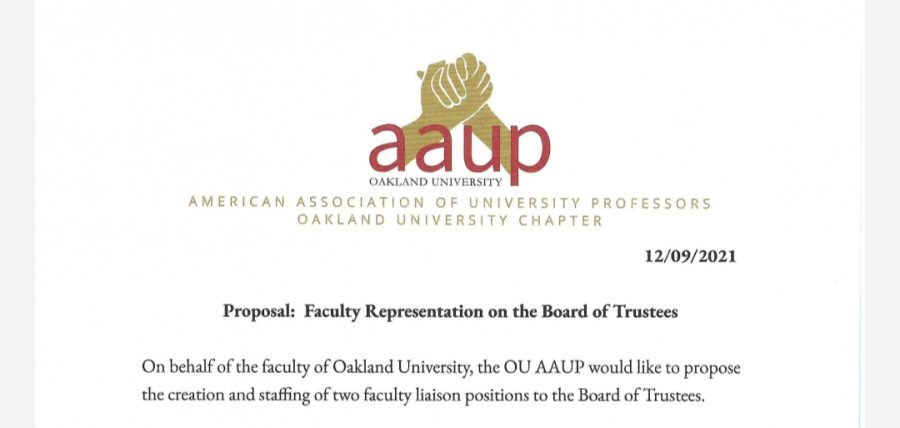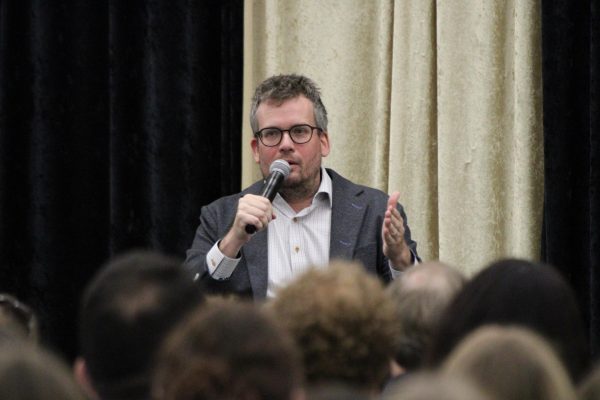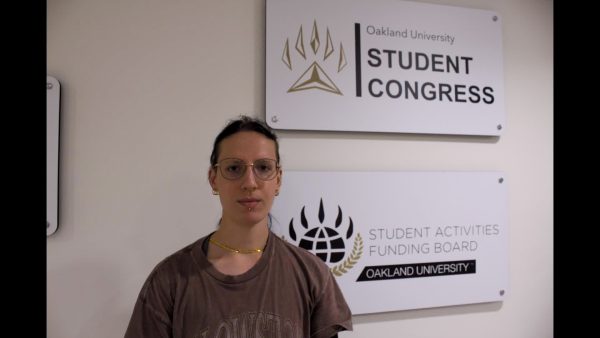OU AAUP formally request two faculty liaison be added to Board of Trustees
The header of the official proposal from OU AAUP to add two faculty liaisons to OU’s Board of Trustees.
Ahead of Monday’s Board of Trustees (BOT) meeting, Oakland University’s chapter of the American Association of University Professors (OU AAUP) has sent a proposal to the administration formally requesting that two faculty liaisons be added to the BOT. That proposal reads:
“On behalf of the faculty of Oakland University, the OU AAUP would like to propose the creation and staffing of two faculty liaison positions to the Board of Trustees.
The OU AAUP has long-held that faculty representation on the Board of Trustees is in the best interest of the University and is long overdue. Trust, understanding and cooperation can only exist when all interested parties have a seat at the table. Since the Board of Trustees is charged with “control and direction of all expenditures from the institution’s funds”, its mission and the mission of the faculty are inextricably intertwined. The University’s Strategic Goal #4 proclaims a desire to “[a]dvance diversity, equity and inclusion in an environment of mutual trust and respect at all levels of the institution and facilitate opportunities and success for all community members.” Since 1994, students have, rightfully, had representation to the Board of Trustees. Faculty are simply asking for the same, rightful, representation as that afforded to their students.
In its 2014 statement on the subject, the national AAUP argued: “College and university governance works best when each constituency within the institution clearly understands its role and relationship to the other constituents and when communication among the governing board, the administration, and the faculty is regular, open and unmediated.” Their conclusion: “In sum, effective faculty-board communication is a critical component of shared governance. Its absence can result in serious misunderstanding between campus constituents and in significant governance failures leading to flawed decision making.”
Near the beginning of each winter term, faculty will be invited to submit their names if they wish to be considered for a one-year term (August 15th through August 14) as a faculty liaison to the Board of Trustees. By the end of each winter term, Oakland will appoint two faculty liaisons out of the pool of interested candidates, at least one of whom is an OU AAUP voting member. These faculty liaisons will attend and be able to participate in all public meetings of the Board.
In this past year, serious disconnects between faculty and campus leadership have made themselves painfully visible. Such divides serve no members of the campus community. Opening a previously closed pathway between faculty and campus leadership through faculty representation on the Board of Trustees offers one simple, tangible and extraordinarily feasible action Oakland can take today to begin to repair the campus community.”
The “serious disconnects between faculty and campus leadership” that the letter alludes to presumably relate to tensions that arose during this year’s faculty contract negotiations. An OU AAUP survey of their members conducted following the negotiations indicated faculty discontent and a general lack of faith in the administration.
Concerning the request, President Ora Hirsch Pescovitz provided a statement to The Post saying, “This request was received late on Thursday by the Oakland University Board of Trustees and they have not yet had an opportunity to fully consider or discuss the request.”
Given President Pescovitz’s statement, it seems unlikely that the request will be formally responded to during next Monday’s BOT meeting which is taking place from 2 p.m. to 3 p.m. in Banquet Room A of the Oakland Center. The next BOT meeting following Monday is scheduled for Feb. 7.
During the Oct. 11 BOT meeting, OU AAUP President Karen Miller spoke during the public comment section and informally requested that the BOT add a faculty liaison. That request went unacknowledged. At that time Miller elaborated on the purpose of the liaison.
“The idea would be that hopefully there would be some trust developed,” Miller said. “Hopefully that liaison could make recommendations to members of the board specifically on policy issues, and say, ‘if you do this, this would be good, this would be bad,’ and help them [make decisions] … [Also] that faculty liaison could be a kind of conduit to other connections with the faculty and with the student body.”
In addition to this request from faculty, Monday will also be the first of meeting with newly appointed BOT member David Kramer. The Post will be following up with an article following the meeting.






